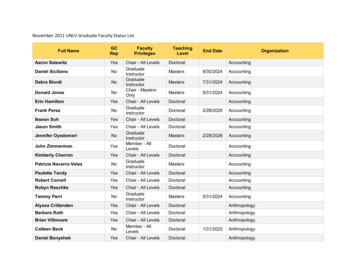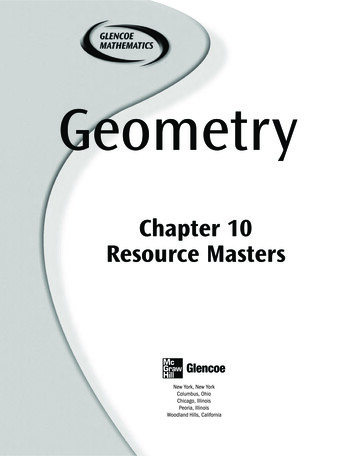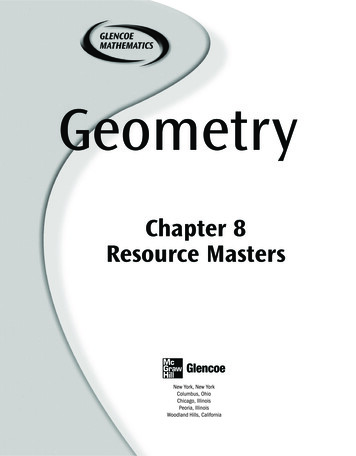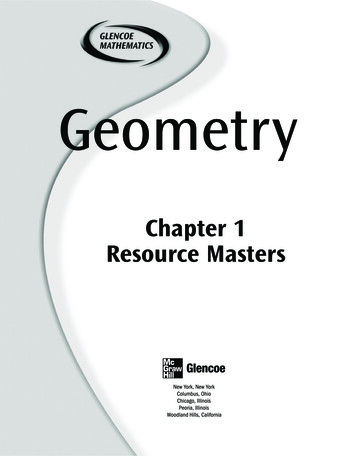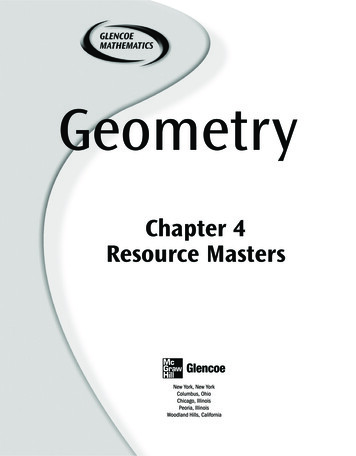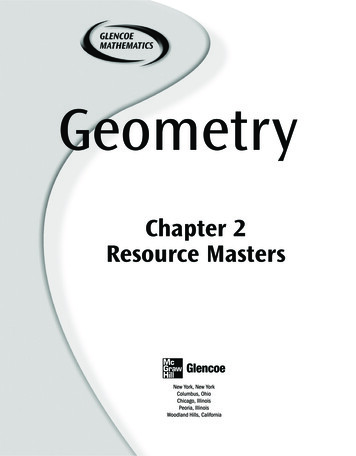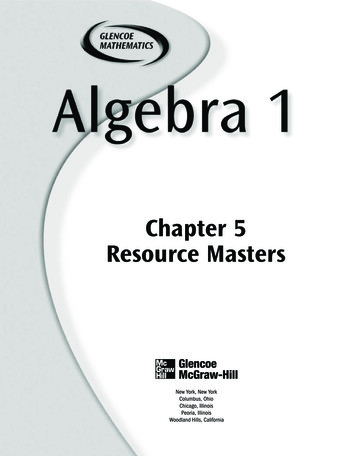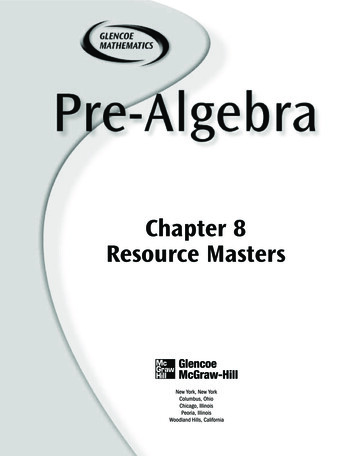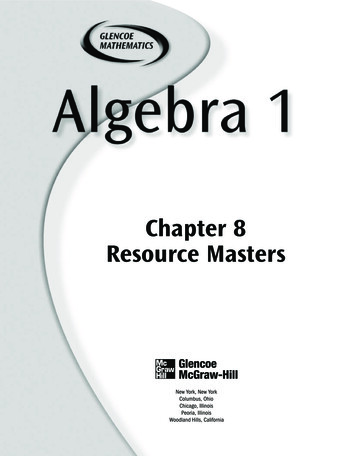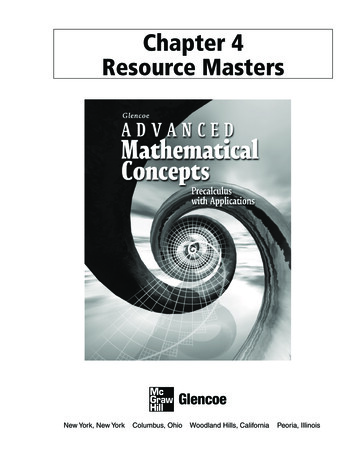
Transcription
Chapter 4Resource MastersNew York, New YorkColumbus, OhioWoodland Hills, CaliforniaPeoria, Illinois
StudentWorksTM This CD-ROM includes the entire Student Edition along with theStudy Guide, Practice, and Enrichment masters.TeacherWorksTM All of the materials found in this booklet are included for viewingand printing in the Advanced Mathematical Concepts TeacherWorksCD-ROM.Copyright The McGraw-Hill Companies, Inc. All rights reserved.Printed in the United States of America. Permission is granted to reproducethe material contained herein on the condition that such material be reproduced onlyfor classroom use; be provided to students, teachers, and families without charge;and be used solely in conjunction with Glencoe Advanced Mathematical Concepts.Any other reproduction, for use or sale, is prohibited without prior writtenpermission of the publisher.Send all inquiries to:Glencoe/McGraw-Hill8787 Orion PlaceColumbus, OH 43240-4027ISBN: 0-07-869131-11 2 3 4 5 6 7 8 9 10Advanced Mathematical ConceptsChapter 4 Resource MastersXXX11 10 09 08 07 06 05 04
ContentsVocabulary Builder . . . . . . . . . . . . . . . . vii-ixLesson 4-7Study Guide . . . . . . . . . . . . . . . . . . . . . . . . . 149Practice . . . . . . . . . . . . . . . . . . . . . . . . . . . . . 150Enrichment . . . . . . . . . . . . . . . . . . . . . . . . . . 151Lesson 4-1Study Guide . . . . . . . . . . . . . . . . . . . . . . . . . 131Practice . . . . . . . . . . . . . . . . . . . . . . . . . . . . . 132Enrichment . . . . . . . . . . . . . . . . . . . . . . . . . . 133Lesson 4-8Study Guide . . . . . . . . . . . . . . . . . . . . . . . . . 152Practice . . . . . . . . . . . . . . . . . . . . . . . . . . . . . 153Enrichment . . . . . . . . . . . . . . . . . . . . . . . . . . 154Lesson 4-2Study Guide . . . . . . . . . . . . . . . . . . . . . . . . . 134Practice . . . . . . . . . . . . . . . . . . . . . . . . . . . . . 135Enrichment . . . . . . . . . . . . . . . . . . . . . . . . . . 136Chapter 4 AssessmentChapter 4 Test, Form 1A . . . . . . . . . . . . 155-156Chapter 4 Test, Form 1B . . . . . . . . . . . . 157-158Chapter 4 Test, Form 1C . . . . . . . . . . . . 159-160Chapter 4 Test, Form 2A . . . . . . . . . . . . 161-162Chapter 4 Test, Form 2B . . . . . . . . . . . . 163-164Chapter 4 Test, Form 2C . . . . . . . . . . . . 165-166Chapter 4 Extended ResponseAssessment . . . . . . . . . . . . . . . . . . . . . . . 167Chapter 4 Mid-Chapter Test . . . . . . . . . . . . . 168Chapter 4 Quizzes A & B . . . . . . . . . . . . . . . 169Chapter 4 Quizzes C & D. . . . . . . . . . . . . . . 170Chapter 4 SAT and ACT Practice . . . . . 171-172Chapter 4 Cumulative Review . . . . . . . . . . . 173Unit 1 Review . . . . . . . . . . . . . . . . . . . . 175-176Unit 1 Test . . . . . . . . . . . . . . . . . . . . . . . 177-180Lesson 4-3Study Guide . . . . . . . . . . . . . . . . . . . . . . . . . 137Practice . . . . . . . . . . . . . . . . . . . . . . . . . . . . . 138Enrichment . . . . . . . . . . . . . . . . . . . . . . . . . . 139Lesson 4-4Study Guide . . . . . . . . . . . . . . . . . . . . . . . . . 140Practice . . . . . . . . . . . . . . . . . . . . . . . . . . . . . 141Enrichment . . . . . . . . . . . . . . . . . . . . . . . . . . 142Lesson 4-5Study Guide . . . . . . . . . . . . . . . . . . . . . . . . . 143Practice . . . . . . . . . . . . . . . . . . . . . . . . . . . . . 144Enrichment . . . . . . . . . . . . . . . . . . . . . . . . . . 145Lesson 4-6Study Guide . . . . . . . . . . . . . . . . . . . . . . . . . 146Practice . . . . . . . . . . . . . . . . . . . . . . . . . . . . . 147Enrichment . . . . . . . . . . . . . . . . . . . . . . . . . . 148 Glencoe/McGraw-HillSAT and ACT Practice Answer Sheet,10 Questions . . . . . . . . . . . . . . . . . . . . . . . A1SAT and ACT Practice Answer Sheet,20 Questions . . . . . . . . . . . . . . . . . . . . . . . A2ANSWERS . . . . . . . . . . . . . . . . . . . . . . A3-A20iiiAdvanced Mathematical Concepts
A Teacher’s Guide to Using theChapter 4 Resource MastersThe Fast File Chapter Resource system allows you to conveniently file theresources you use most often. The Chapter 4 Resource Masters include the corematerials needed for Chapter 4. These materials include worksheets, extensions,and assessment options. The answers for these pages appear at the back of thisbooklet.All of the materials found in this booklet are included for viewing and printing inthe Advanced Mathematical Concepts TeacherWorks CD-ROM.Vocabulary Builder Pages vii-x include aPractice There is one master for each lesson.student study tool that presents the keyvocabulary terms from the chapter. Students areto record definitions and/or examples for eachterm. You may suggest that students highlight orstar the terms with which they are not familiar.These problems more closely follow thestructure of the Practice section of the StudentEdition exercises. These exercises are ofaverage difficulty.When to Use These provide additionalpractice options or may be used as homeworkfor second day teaching of the lesson.When to Use Give these pages to studentsbefore beginning Lesson 4-1. Remind them toadd definitions and examples as they completeeach lesson.Enrichment There is one master for eachlesson. These activities may extend the conceptsin the lesson, offer a historical or multiculturallook at the concepts, or widen students’perspectives on the mathematics they arelearning. These are not written exclusivelyfor honors students, but are accessible for usewith all levels of students.Study Guide There is one Study Guidemaster for each lesson.When to Use Use these masters asreteaching activities for students who needadditional reinforcement. These pages can alsobe used in conjunction with the Student Editionas an instructional tool for those students whohave been absent. Glencoe/McGraw-HillWhen to Use These may be used as extracredit, short-term projects, or as activities fordays when class periods are shortened.ivAdvanced Mathematical Concepts
Assessment OptionsIntermediate AssessmentThe assessment section of the Chapter 4Resources Masters offers a wide range ofassessment tools for intermediate and finalassessment. The following lists describe eachassessment master and its intended use.Chapter Tests Forms 1A, 1B, and 1C Form 1 tests containmultiple-choice questions. Form 1A isintended for use with honors-level students,Form 1B is intended for use with averagelevel students, and Form 1C is intended foruse with basic-level students. These testsare similar in format to offer comparabletesting situations.Forms 2A, 2B, and 2C Form 2 tests arecomposed of free-response questions. Form2A is intended for use with honors-levelstudents, Form 2B is intended for use withaverage-level students, and Form 2C isintended for use with basic-level students.These tests are similar in format to offercomparable testing situations.The Extended Response Assessmentincludes performance assessment tasks thatare suitable for all students. A scoringrubric is included for evaluation guidelines.Sample answers are provided forassessment. Glencoe/McGraw-Hill Four free-response quizzes are included tooffer assessment at appropriate intervals inthe chapter. The SAT and ACT Practice offerscontinuing review of concepts in variousformats, which may appear on standardizedtests that they may encounter. This practiceincludes multiple-choice, quantitativecomparison, and grid-in questions. Bubblein and grid-in answer sections are providedon the master. The Cumulative Review provides studentsan opportunity to reinforce and retain skillsas they proceed through their study ofadvanced mathematics. It can also be usedas a test. The master includes free-responsequestions.AnswersAll of the above tests include a challengingBonus question. A Mid-Chapter Test provides an option toassess the first half of the chapter. It iscomposed of free-response questions.Continuing AssessmentChapter Assessments v Page A1 is an answer sheet for the SAT andACT Practice questions that appear in theStudent Edition on page 273. Page A2 is ananswer sheet for the SAT and ACT Practicemaster. These improve students’ familiaritywith the answer formats they mayencounter in test taking. The answers for the lesson-by-lessonmasters are provided as reduced pages withanswers appearing in red. Full-size answer keys are provided for theassessment options in this booklet.Advanced Mathematical Concepts
Chapter 4 Leveled WorksheetsGlencoe’s leveled worksheets are helpful for meeting the needs of everystudent in a variety of ways. These worksheets, many of which are foundin the FAST FILE Chapter Resource Masters, are shown in the chartbelow. Study Guide masters provide worked-out examples as well as practiceproblems. Each chapter’s Vocabulary Builder master provides students theopportunity to write out key concepts and definitions in their ownwords. Practice masters provide average-level problems for students whoare moving at a regular pace. Enrichment masters offer students the opportunity to extend theirlearning.Five Different Options to Meet the Needs ofEvery Student in a Variety of Waysprimarily skillsprimarily conceptsprimarily applicationsBASICAVERAGE1Study Guide2Vocabulary Builder3Parent and Student Study Guide (online) dvanced Mathematical Concepts
NAME DATE PERIODChapter4Reading to Learn MathematicsVocabulary BuilderThis is an alphabetical list of the key vocabulary terms you will learn in Chapter 4.As you study the chapter, complete each term’s definition or description.Remember to add the page number where you found the term.Vocabulary TermFoundon PageDefinition/Description/Examplecompleting the squarecomplex numberconjugatedegreedepressed polynomialDescartes’ Rule of Signsdiscriminantextraneous solutionFactor TheoremFundamental Theorem of Algebra(continued on the next page) Glencoe/McGraw-HillviiAdvanced Mathematical Concepts
NAME DATE PERIODChapter4Reading to Learn MathematicsVocabulary Builder (continued)Vocabulary TermFoundon PageDefinition/Description/Exampleimaginary numberIntegral Root Theoremleading coefficientLocation Principlelower boundlower Bound Theorempartial fractionspolynomial equationpolynomial functionpolynomial in one variablepure imaginary number(continued on the next page) Glencoe/McGraw-HillviiiAdvanced Mathematical Concepts
NAME DATE PERIODChapter34Reading to Learn MathematicsVocabulary Builder (continued)Vocabulary TermFoundon PageDefinition/Description/ExampleQuadratic Formularadical equationradical inequalityrational equationrational inequalityRational Root theoremRemainder Theoremsynthetic divisionupper boundUpper Bound Theoremzero Glencoe/McGraw-HillixAdvanced Mathematical Concepts
BLANK
NAME DATE PERIOD4-1Study GuidePolynomial FunctionsThe degree of a polynomial in one variable is the greatest exponent ofits variable. The coefficient of the variable with the greatest exponentis called the leading coefficient. If a function ƒ(x) is defined by apolynomial in one variable, then it is a polynomial function. The valuesof x for which ƒ(x) 0 are called the zeros of the function. Zeros of thefunction are roots of the polynomial equation when ƒ(x) 0. Apolynomial equation of degree n has exactly n roots in the set ofcomplex numbers.Example 1State the degree and leading coefficient of the polynomial 2 is afunction ƒ(x) 6x5 8x3 8x. Then determine whether 3zero of ƒ(x).6x5 8x3 8x has a degree of 5 and a leading coefficient of 6.2 . That is, find ƒ 2 .Evaluate the function for x 3 32 6 2 8 2 8 2 ƒ 3 3 3 3 532 x 32 1 6 2 8 2 294 333 3 02 0, 2 is a zero of ƒ(x) 6x5 8x3 8x.Since ƒ 33 Example 2 i,Write a polynomial equation of least degree with roots 0, 2and 2 i.The linear factors for the polynomial are x 0, x 2 i, and x 2 i.Find the products of these factors. i)(x 2 i) (x 0)(x 22 2i2) x(xx(x2 2) x3 2x Example 3000 2i2 2( 1) or 20State the number of complex roots of theequation 3x2 11x 4 0. Then find the roots.The polynomial has a degree of 2, so there are twocomplex roots. Factor the equation to find the roots.3x2 11x 4 0(3x 1)(x 4) 0To find each root, set each factor equal to zero.3x 1 0x 4 03x 1x 41x 3 The roots are 4 and 13 . Glencoe/McGraw-Hill131Advanced Mathematical Concepts
NAME DATE PERIOD4-1PracticePolynomial FunctionsState the degree and leading coefficient of each polynomial.1. 6a4 a3 2a2. 3p2 7p5 2p3 5Write a polynomial equation of least degree for each set of roots.3. 3, 0.5, 14. 3, 3, 1, 1, 25. 2i, 3, 36. 1, 3 i, 2 3iState the number of complex roots of each equation. Then findthe roots and graph the related function.7. 3x 5 08. x2 4 09. c 2 2c 1 010. x3 2x2 15x 011. Real Estate A developer wants to build homes on a rectangular plot of land 4 kilometers long and 3 kilometers wide. In thispart of the city, regulations require a greenbelt of uniform widthalong two adjacent sides. The greenbelt must be 10 times thearea of the development. Find the width of the greenbelt. Glencoe/McGraw-Hill132Advanced Mathematical Concepts
NAME DATE PERIOD4-1EnrichmentGraphic AdditionOne way to sketch the graphs of some polynomialfunctions is to use addition of ordinates. This method isuseful when a polynomial function f (x) can be writtenas the sum of two other functions, g(x) and h(x), thatare easier to graph. Then, each f (x) can be found bymentally adding the corresponding g(x) and h(x). Thegraph at the right shows how to construct the graph of1 31 31 2x – 8 from the graphs of g(x) – xf(x) – x 222and h(x) 1 x22– 8.In each problem, the graphs of g(x) and h(x) are shown. Use addition of ordinates tograph a new polynomial function f(x), such that f(x) g(x) h(x). Then write theequation for f(x).1.2.3.4.5.6. Glencoe/McGraw-Hill133Advanced Mathematical Concepts
NAME DATE PERIOD4-2Study GuideQuadratic EquationsA quadratic equation is a polynomial equation with a degree of 2.Solving quadratic equations by graphing usually does not yieldexact answers. Also, some quadratic expressions are not factorable.However, solutions can always be obtained by completing thesquare.Example 1Solve x2 12x 7 0 by completing the square.x2 12x 7 0Subtract 7 from each side.x2 12x 72Completethe square by adding 12 ( 12) ,2x 12x 36 7 36or 36, to each side.Factor the perfect square trinomial.(x 6)2 29 9 Take the square root of each side.x 6 2 9 Add 6 to each side.x 6 2The roots of the equation are 6 2 9 .Completing the square can be used to develop a general formula forsolving any quadratic equation of the form ax2 bx c 0. Thisformula is called the Quadratic Formula and can be used to findthe roots of any quadratic equation.Quadratic Formula b 2 2ab 4ac .If ax2 bx c 0 with a 0, x In the Quadratic Formula, the radicand b2 4ac is called thediscriminant of the equation. The discriminant tells thenature of the roots of a quadratic equation or the zeros of therelated quadratic function.Example 2Find the discriminant of 2x2 3x 7 anddescribe the nature of the roots of the equation.Then solve the equation by using the QuadraticFormula.Rewrite the equation using the standard form ax2 bx c 0.2x2 3x 7 0 a 2, b 3, and c 7The value of the discriminant b2 4ac is( 3)2 4(2)( 7), or 65.Since the value of the discriminant is greater thanzero, there are two distinct real roots.Now substitute the coefficients into the quadraticformula and solve. 3 ) (24 )( 7 ) ( 3) ( x 2(2)2 b b 2 a4 c x 2a3 6 5 x 43 6 5 and 3 6 5 . The roots are 44 Glencoe/McGraw-Hill134Advanced Mathematical Concepts
NAME DATE PERIOD4-2PracticeQuadratic EquationsSolve each equation by completing the square.1. x2 5x 141 02. 4x2 11x 7Find the discriminant of each equation and describe the nature ofthe roots of the equation. Then solve the equation by using theQuadratic Formula.4. 4x2 4x 15 03. x2 x 6 05. 9x2 12x 4 06. 3x2 2x 5 0Solve each equation.7. 2x2 5x 12 08. 5x2 14x 11 09. Architecture The ancient Greek mathematicians thought thatthe most pleasing geometric forms, such as the ratio of the heightto the width of a doorway, were created using the golden section.However, they were surprised to learn that the golden section is nota rational number. One way of expressing the golden section isA B AC . Ifby using a line segment. In the line segment shown, ACCBAB .AC 1 unit, find the ratio AC Glencoe/McGraw-Hill135Advanced Mathematical Concepts
NAME DATE PERIOD4-2EnrichmentConjugates and Absolute ValueWhen studying complex numbers, it is often convenient to representa complex number by a single variable. For example, we might letz x yi. We denote the conjugate of z by z. Thus, z x yi.We can define the absolute value of a complex number as follows.2 y 2 z x yi x There are many important relationships involving conjugates andabsolute values of complex numbers.Show that z2 zz for any complex number z.Let z x yi. Then,Examplezz (x yi)(x yi) x 2 y22 x y 2 2 z 2z Show thatis the multiplicative inverse for any2Example z nonzero complex number z.We know that z 2 zz . If z 0, then we have z z z z 1. Thus,is the multiplicative22 z inverse of z.For each of the following complex numbers, find the absolutevalue and multiplicative inverse.1. 2i2. –4 3i3. 12 5i4. 5 12i5. 1 i i6. 37. 3 3 3 i3 Glencoe/McGraw-Hill8. 2 2 2 i21369.1 2 3 i2Advanced Mathematical Concepts
NAME DATE PERIOD4-3Study GuideThe Remainder and Factor TheoremsThe RemainderTheoremExample 1If a polynomial P(x) is divided by x r, the remainder is a constant P(r ),and P(x) (x r ) Q(x) P(r )where Q(x) is a polynomial with degree one less than the degree of P(x).Divide x4 5x2 17x 12 by x 3.x3 3x2 4x 29 4 x0 3 x5 2 71 x 21 x 3 x43x 3x 3x3 5x2 3x3 9x24x2 17x4x2 12x 29x 12 29x 8775 remainderFind the value of rin this division.x r x 3 r 3r 3According to theRemainder Theorem,P(r) or P( 3) shouldequal 75.Use the Remainder Theorem to check the remainder found bylong division.P(x) x4 5x2 17x 12P( 3) ( 3)4 5( 3)2 17( 3) 12 81 45 51 12 or 75The Factor Theorem is a special case of the RemainderTheorem and can be used to quickly test for factors ofa polynomial.The FactorTheoremExample 2The binomial x r is a factor of the polynomial P(x) if and only if P(r) 0.Use the Remainder Theorem to find theremainder when 2x3 5x2 14x 8 is divided byx 2. State whether the binomial is a factor ofthe polynomial. Explain.Find ƒ(2) to see if x 2 is a factor.ƒ(x) 2x3 5x2 14x 8ƒ(2) 2(2)3 5(2)2 14(2) 8 16 20 28 8 0Since ƒ(2) 0, the remainder is 0. So thebinomial x 2 is a factor of the polynomialby the Factor Theorem. Glencoe/McGraw-Hill137Advanced Mathematical Concepts
NAME DATE PERIOD4-3PracticeThe Remainder and Factor TheoremsDivide using synthetic division.1. (3x2 4x 12) (x 5)2. (x2 5x 12) (x 3)3. (x 4 3x2 12) (x 1)4. (2x3 3x2 8x 3) (x 3)Use the Remainder Theorem to find the remainder for each division.State whether the binomial is a factor of the polynomial.5. (2x4 4x3 x2 9) (x 1)6. (2x3 3x2 10x 3) (x 3)7. (3t 3 10t 2 t 5) (t 4)8. (10x3 11x2 47x 30) (x 2)9. (x4 5x3 14x2) (x 2)11. ( y3 y2 10) ( y 3)10. (2x4 14x3 2x2 14x) (x 7)12. (n4 n3 10n2 4n 24) (n 2)13. Use synthetic division to find all the factors of x3 6x2 9x 54if one of the factors is x 3.14. Manufacturing A cylindrical chemical storage tank must havea height 4 meters greater than the radius of the top of the tank.Determine the radius of the top and the height of the tank if thetank must have a volume of 15.71 cubic meters. Glencoe/McGraw-Hill138Advanced Mathematical Concepts
NAME DATE PERIOD4-3EnrichmentThe Secret Cubic EquationYou might have supposed that there existed simple formulas forsolving higher-degree equations. After all, there is a simple formulafor solving quadratic equations. Might there not be formulas forcubics, quartics, and so forth?There are formulas for some higher-degree equations, but they arecertainly not “simple” formulas!Here is a method for solving a reduced cubic of the formx 3 ax b 0 published by Jerome Cardan in 1545. Cardan wasgiven the formula by another mathematician, Tartaglia. Tartagliamade Cardan promise to keep the formula secret, but Cardanpublished it anyway. He did, however, give Tartaglia the credit forinventing the formula! x – b RLet R Then,21 b2 1 2a3 271 3 1– b2 R 1 3Use Cardan’s method to find the real root of each cubic equation. Round answersto three decimal places. Then sketch a graph of the corresponding function on thegrid provided.1. x3 8x 3 02. x3 – 2x – 5 03. x3 4x – 1 04. x3 – x 2 0 Glencoe/McGraw-Hill139Advanced Mathematical Concepts
NAME DATE PERIOD4-4Study GuideThe Rational Root TheoremThe Rational Root Theorem provides a means of determiningpossible rational roots of an equation. Descartes’ Rule of Signscan be used to determine the possible number of positive real zerosand the possible number of negative real zeros.RationalRootTheoremLet a0 x n a1 x n 1 . . . an 1 x an 0 represent a polynomial equation ofpdegree n with integral coefficients. If a rational number , where p and qqhave no common factors, is a root of the equation, then p is a factor of anand q is a factor of a0.Example 1List the possible rational roots ofx3 5x2 17x 6 0. Then determinethe rational roots.p is a factor of 6 and q is a factor of 1possible values of p: 1, 2, 3, 6possible values of q: 1ppossible rational roots, q : 1, 2, 3, 6Test the possible roots using synthetic division.r1 12 23 36 6Example 2111111111 5 4 6 3 7 2 81 11 17 21 11 23 3 237 1149 6 275 520 75 27 72 300 There is a root at x 2.The depressed polynomial is x2 7x 3.You can use the Quadratic Formula tofind the two irrational roots.Find the number of possible positive real zerosand the number of possible negative real zerosfor f(x) 4x4 13x3 21x2 38x 8.According to Descartes’ Rule of Signs, the number ofpositive real zeros is the same as the number of signchanges of the coefficients of the terms in descendingorder or is less than this by an even number. Count thesign changes.ƒ(x) 4x4 13x3 21x2 38x 84 13 2138 8There are three changes. So, there are 3 or 1 positivereal zeros.The number of negative real zeros is the same as thenumber of sign changes of the coefficients of the termsof ƒ( x), or less than this number by an even number.ƒ( x) 4( x)4 13( x)3 21( x)2 38( x) 8413 21 38 8There is one change. So, there is 1 negative real zero Glencoe/McGraw-Hill140Advanced Mathematical Concepts
NAME DATE PERIOD4-4PracticeThe Rational Root TheoremList the possible rational roots of each equation. Then determinethe rational roots.1. x3 x2 8x 12 02. 2x3 3x2 2x 3 03. 36x4 13x2 1 04. x3 3x2 6x 8 05. x4 3x3 11x2 3x 10 06. x4 x2 2 07. 3x3 x2 8x 6 08. x3 4x2 2x 15 0Find the number of possible positive real zeros and the number ofpossible negative real zeros. Then determine the rational zeros.10. ƒ(x) x4 x3 7x2 x 69. ƒ(x) x3 2x2 19x 2011. Driving An automobile moving at 12 meters per secondon level ground begins to decelerate at a rate of 1.6 metersper second squared. The formula for the distancean object has traveled is d(t) v0 t 21 at 2, where v0 is theinitial velocity and a is the acceleration. For what value(s) oft does d(t) 40 meters? Glencoe/McGraw-Hill141Advanced Mathematical Concepts
NAME DATE PERIOD4-4EnrichmentScrambled ProofsThe proofs on this page have been scrambled. Number thestatements in each proof so that they are in a logical order.The Remainder TheoremThus, if a polynomial f (x) is divided by x – a, the remainder is f (a).In any problem of division the following relation holds:dividend quotient divisor remainder. In symbols,this may be written as:Equation (2) tells us that the remainder R is equal to the value f (a); that is,f (x) with a substituted for x.For x a, Equation (1) becomes:Equation (2) f (a) R,since the first term on the right in Equation (1) becomes zero.Equation (1) f (x) Q(x)(x – a) R,in which f (x) denotes the original polynomial, Q(x) is the quotient, and R theconstant remainder. Equation (1) is true for all values of x, and in particular,it is true if we set x a.The Rational Root TheoremEach term on the left side of Equation (2) contains the factor a; hence, a mustbe a factor of the term on the right, namely, – cnbn. But by hypothesis, a isnot a factor of b unless a 1. Hence, a is a factor of cn.f a n b c0a n b c1a n–1 b c . . . cn – 1a bn 0Thus, in the polynomial equation given in Equation (1), a is a factor of cn andb is a factor of c0.In the same way, we can show that b is a factor of c0.A polynomial equation with integral coefficients of the formEquation (1)has a rational roota ba bf (x) c0xn c1xn – 1 . . . cn – 1x cn 0, where the fractiona bis reduced to lowest terms. Sinceis a root of f (x) 0, thenIf each side of this equation is multiplied by bn and the last term istransposed, it becomesEquation (2) Glencoe/McGraw-Hillc0an c1an – 1b . . . cn – 1abn – 1 – cnbn142Advanced Mathematical Concepts
NAME DATE PERIOD4-5Study GuideLocating Zeros of a Polynomial FunctionA polynomial function may have real zeros that are not rationalnumbers. The Location Principle provides a means of locating andapproximating real zeros. For the polynomial function y ƒ(x), if aand b are two numbers with ƒ(a) positive and ƒ(b) negative, thenthere must be at least one real zero between a and b. For example, ifƒ(x) x2 2, ƒ(0) 2 and ƒ(2) 2. Thus, a zero exists somewherebetween 0 and 2.The Upper Bound Theorem and the Lower Bound Theorem arealso useful in locating the zeros of a function and in determiningwhether all the zeros have been found. If a polynomial function P(x)is divided by x c, and the quotient and the remainder have nochange in sign, c is an upper bound of the zeros of P(x). If c is anupper bound of the zeros of P( x), then c is a lower bound of thezeros of P(x).Example 1Determine between which consecutive integers thereal zeros of ƒ(x) x3 2x2 4x 5 are located.According to Descartes’ Rule of Signs, there are two or zeropositive real roots and one negative real root. Use syntheticdivision to evaluate ƒ(x) for consecutive integral values of x.r 1 2 45There is a zero at 1. The changes 4 1 620 75in sign indicate that there are 3 1 511 28also zeros between 2 and 1 2 1 44 3 1 1 3 16and between 2 and 3. This result0 1 2 45is consistent with Descartes’ Rule1 1 1 50of Signs.2 10 4 33Example 21 112Use the Upper Bound Theorem to show that 3 is anupper bound and the Lower Bound Theorem toshow that 2 is a lower bound of the zeros ofƒ(x) x3 3x2 x 1.Synthetic division is the most efficient way to test potentialupper and lower bounds. First, test for the upper bound.r311 3011 12Since there is no change in the signs in the quotientand remainder, 3 is an upper bound.Now, test for the lower bound of ƒ(x) by showing that 2is an upper bound of ƒ( x).ƒ( x) ( x)3 3( x)2 ( x) 1 x3 3x2 x 1r2 1 1 3 5 1 11 1 23Since there is no change in the signs, 2 is a lower bound of ƒ(x). Glencoe/McGraw-Hill143Advanced Mathematical Concepts
NAME DATE PERIOD4-5PracticeLocating Zeros of a Polynomial FunctionDetermine between which consecutive integers the real zeros ofeach function are located.2. ƒ(x) 2x3 5x2 7x 31. ƒ(x) 3x3 10x2 22x 43. ƒ(x) 2x3 13x2 14x 44. ƒ(x) x3 12x2 17x 95. ƒ(x) 4x4 16x3 25x2 196x 1466. ƒ(x) x3 9Approximate the real zeros of each function to the nearest tenth.7. ƒ(x) 3x4 4x2 18. ƒ(x) 3x3 x 29. ƒ(x) 4x4 6x2 111. ƒ(x) x3 2x2 2x 310. ƒ(x) 2x3 x2 112. ƒ(x) x3 5x2 4Use the Upper Bound Theorem to find an integral upper bound andthe Lower Bound Theorem to find an integral lower bound of thezeros of each function.13. ƒ(x) 3x4 x3 8x2 3x 20 14. ƒ(x) 2x3 x2 x 615. For ƒ(x) x3 3x2, determine the number and type ofpossible complex zeros. Use the Location Principle todetermine the zeros to the nearest tenth. The graph has arelative maximum at (0, 0) and a relative minimum at(2, 4). Sketch the graph. Glencoe/McGraw-Hill144Advanced Mathematical Concepts
NAME DATE PERIOD4-5EnrichmentThe Bisection Method for Approximating Real ZerosThe bisection method can be used to approximate zeros ofpolynomial functions like f (x) x3 x2 3x 3. Since f (1) –4 and f (2) 3, there is at least one rea
Aug 25, 2014 · Forms 2A, 2B, and 2C Form 2 tests are composed of free-response questions. Form 2A is intended for use with honors-level students, Form 2B is intended for use with average-level students, and Form 2C is intended for use with basic-level students. These tests are


